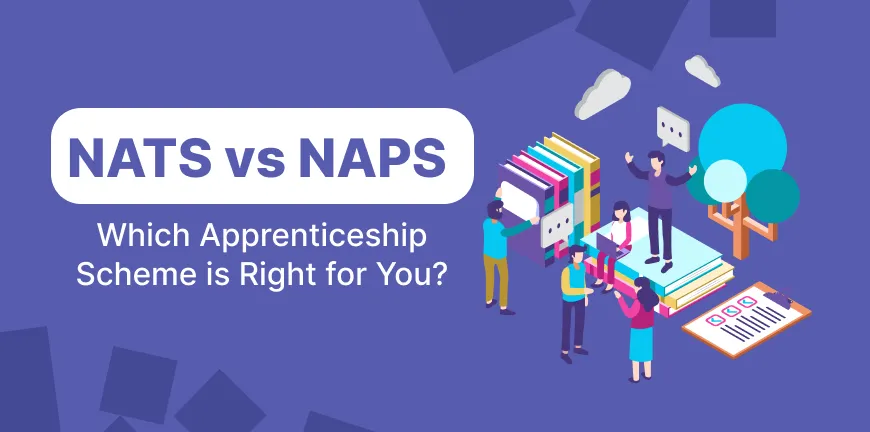
Fintech & BFSI Talent Needs: The Rise of Risk, Compliance, and Digital Roles
04/09/2025
Government Incentives Under NAPS for Employers
07/09/2025- What Is NAPS and How Does It Support Workforce Development?
- Top 10 Industries Using NAPS for Building Workforce
- How Does NAPS Benefit the Manufacturing Sector?
- How Can IT Companies Leverage NAPS for Skilled Talent?
- How Does NAPS Help Build a Skilled Workforce in Healthcare?
- What Role Does NAPS Play in Upskilling Automotive Professionals?
- How Are Hospitality and Tourism Companies Using NAPS for Workforce Development?
- How Can SMEs Utilize NAPS to Train Their Workforce?
- How Do Public Sector Organizations Implement NAPS for Skill Development?
- Conclusion
- Frequently Asked Questions
Every apprentice trained under NAPS represents an investment in India’s economic progress and workforce resilience.” – Industry Experts.
The NAPS program has become a huge success with nearly 3.5 million apprentices and 2.2 lakh establishments becoming part of its journey and still counting. The flexibility of allowing employers to design training programs according to their business needs and contribution to training expenses makes NAPS an ally for companies across all sectors to build a continuous pipeline of skilled workforce. However, there are certain industries that maximise NAPS benefits than others due to their strong desire to build a skilled entry-level workforce with lesser costs.
Let’s discuss the top 10 industries that are leveraging NAPS to build a strong talent pipeline and learn how they utilise NAPS in the best possible way.
What Is NAPS and How Does It Support Workforce Development?
NAPS, or the National Apprenticeship Promotion Scheme, is a government-supported apprenticeship program intended to improve employability and help companies find skilled talent to meet their business goals across sectors. The NAPS apprenticeship program encompasses basic training and on-the-job training/practical training at the work premises of the employer. The key objectives of the NAPS program include:
- To promote apprenticeship training throughout India.
- To build a skilled workforce that will help in the economic growth of the country.
- To encourage employers to enroll apprentices on a large scale by covering a portion of the training expenses and providing stipends to apprentices to financially support them during the training period.
- To offer up-skilling opportunities for candidates who have undergone short-term skill training through various Central and State Government initiatives.
- To encourage the enrolment of apprentices in micro industries and SMEs spread across urban and rural areas throughout India.
Here are 5 ways NAPs support workforce development:
- NAPS helps in developing industry-ready apprentices by diligently blending classroom curriculum with structured, hands-on, and practical training.
- Employers get free rein to churn out customized training programs under NAPS, enabling them to align workforce skills directly with evolving industry standards & requirements.
- Government-funded stipends provided via NAPS encourage employers to train more apprentices, expanding access to structured workforce development opportunities.
- NAPS acts as a bridge to reduce the gap between academic learning & workplace demands, ensuring smoother school-to-workforce transitions.
- Sustained apprenticeship engagement through NAPS builds long-term talent pipelines, reducing hiring gaps and strengthening organizational workforce stability.
Top 10 Industries Using NAPS for Building Workforce
Here are the top 10 industries that are using the NAPS program to build their talent pipeline:
1. Manufacturing
Manufacturing companies leverage NAPS to train candidates in various production operations like machine operations, welding, assembly, etc., ensuring a diverse pipeline of skilled shop-floor talent is always available.
2. Information Technology (IT)
IT firms enroll in NAPS for developing software testers, support engineers, & cybersecurity apprentices, addressing critical digital skill gaps effectively.
3. Automotive
Automotive manufacturers adopt NAPS to train apprentices in assembly lines, vehicle maintenance, & EV technologies, ensuring a future-ready mobility workforce.
4. Healthcare
Hospitals and healthcare providers utilize NAPS to train paramedics, lab technicians, & healthcare assistants, strengthening India’s essential medical support systems.
5. Retail & E-commerce
Retailers and e-commerce platforms implement NAPS to build skilled supply chain, inventory, and customer service professionals for rapid business scaling.
6. Banking & Financial Services
Banks adopt NAPS to groom apprentices in digital banking, financial operations, and compliance roles, preparing the workforce for a fintech-driven future.
7. Telecommunications
Telecom operators leverage NAPS to train network engineers, customer service apprentices, and technicians, supporting India’s expanding 5G connectivity infrastructure growth.
8. Hospitality & Tourism
Hotels and travel companies use NAPS to build skilled chefs, housekeeping staff, and guest relations teams to improve service excellence.
9. Construction & Infrastructure
Construction firms adopt NAPS for training site supervisors, masons, and technicians, enhancing productivity and safety standards in growing infrastructure projects.
10. Logistics & Transportation
Logistics companies leverage NAPS to train apprentices in warehouse operations, fleet management, and last-mile delivery for efficient nationwide distribution.
How Does NAPS Benefit the Manufacturing Sector?
Here are 5 ways NAPS helps companies operating in the manufacturing sector build a skilled workforce:
1. Building Industry-Ready Technical Skills
NAPS equips manufacturing apprentices with practical, industry-relevant skills in machining, welding, and operations. This approach reduces training gaps and ensures a steady supply of technically skilled, job-ready candidates for production lines.
2. Reducing Training Costs for Employers
By subsidizing training costs, NAPS empowers manufacturers to train large apprentice batches affordably. This strengthens skill pipelines, boosts productivity, and reduces overall workforce expenses in a competitive industrial environment.
3. Bridging Academia and Industry Requirements
NAPS bridges academia-industry gaps by matching apprenticeship training with actual shop-floor requirements. This flexible approach ensures graduates transition smoothly into factory roles, minimizing onboarding challenges and improving operational efficiency across manufacturing plants.
4. Preparing for Industry 4.0 Innovations
Apprenticeship programs under NAPS support emerging technologies like robotics, EV manufacturing, & automation. This adaptability of aligning training programs to the latest technology helps in preparing future-ready manufacturing talent that is suited to Industry 4.0 innovations and global industrial standards.
5. Strengthening Workforce Retention and Stability
Sustained NAPS-driven apprenticeship training enhances retention rates, reduces labour shortages, and fosters a continuous talent pipeline. This empowers manufacturing companies to scale operations with confidence and long-term workforce stability.
How Can IT Companies Leverage NAPS for Skilled Talent?
IT companies are experiencing a rise in demand for digital skills. Leveraging NAPS, they can build a future-ready workforce, reduce training costs, and create a steady pipeline of skilled IT talent.
1. Developing Entry-Level Tech Talent
The NAPS program offers unlimited flexibility for IT firms to train apprentices in programming, testing, and support. This bridges academic gaps & builds a continuous talent pool of job-ready, entry-level software professionals.
2. Reducing Hiring and Training Costs
Government incentives of around 25% under NAPS reduce financial burdens on IT companies. This makes workforce development more affordable while ensuring large-scale apprentice training is in place for evolving digital business requirements.
3. Addressing Skill Gaps in Emerging Technologies
NAPS apprenticeships empower IT firms to train talent in AI, cloud computing, cybersecurity, & data analytics. This new-age learning approach helps in meeting critical workforce needs in next-generation digital domains.
4. Enhancing Retention and Workforce Stability
Apprentices trained through NAPS show higher loyalty. This unwavering commitment-driven attitude reduces attrition rates in IT companies and ensures stable, long-term talent pipelines for scaling operations.
5. Building Industry-Academia Collaboration
NAPS perfectly blends academic learning and corporate needs, helping IT companies create tailored training programs that align with fast-changing technology skill demands effectively.
How Does NAPS Help Build a Skilled Workforce in Healthcare?
The healthcare sector demands skilled professionals for quality patient care. NAPS empowers hospitals to train apprentices cost-effectively, ensuring industry-aligned skills, sustainable workforce pipelines, and improved patient outcomes across healthcare services. Here are 5 ways NAPS helps the healthcare sector in building a skilled workforce:
1. Practical Clinical Training
The National Apprenticeship Promotion Scheme equips hospitals and clinics with structured, hands-on training that helps apprentices hone their skills in critical departments like nursing, diagnostics, and patient care. This approach bridges academic knowledge with real-world clinical expertise.
2. Cost-Effective Workforce Development
Through government-funded stipend reimbursements, healthcare institutions are able to reduce training expenses by a significant margin while grooming job-ready apprentices. This ensures an affordable and sustainable workforce development aligned with industry demands and future patient care needs.
3. Addressing Talent Shortages
By engaging apprentices under NAPS, hospitals overcome chronic shortfalls of skilled healthcare professionals in critical roles like nursing, lab technology, and diagnostics. This ensures the continuous availability of patient care talent across departments.
4. Industry-Aligned Skill Building
NAPS allows healthcare employers to develop apprenticeship programs matching hospital requirements. This ensures apprentices acquire relevant, industry-specific skills that boost employability and directly enhance the quality of healthcare delivery.
5. Strengthening Long-Term Workforce Pipelines
With structured on-the-job training, NAPS supports healthcare institutions in developing a steady pipeline of skilled professionals. This program reduces attrition, recruitment delays, and ensures sustainable workforce growth across diverse healthcare roles.
What Role Does NAPS Play in Upskilling Automotive Professionals?
The automotive industry requires constant innovation and skilled talent. NAPS helps companies train apprentices in cutting-edge automotive skills, fostering productivity, efficiency, and sustainable workforce pipelines for long-term industry competitiveness.
1. Training in Advanced Vehicle Technologies
NAPS offers ample opportunities for apprentices to learn electric mobility, hybrid systems, & connected car technologies. This helps in building a workforce skilled in next-generation automotive solutions for global markets.
2. Skilled Workforce for Manufacturing & Assembly
Apprentices trained under NAPS gain hands-on expertise in vehicle assembly, machining, & quality testing. This ensures operational efficiency and reduces skill shortages in production facilities.
3. Strengthening After-Sales Service & Repairs
NAPS equips apprentices with diagnostic, servicing, & repair skills. This empowers automotive companies to enhance customer satisfaction & retain loyal clientele through efficient after-sales services.
4. R&D and Innovation Support
With NAPS, apprentices assist in research, design, and prototype development, supporting automotive firms in achieving faster innovation, competitive advantage, and sustainable technology-driven growth.
5. Building a Sustainable Supply Chain Workforce
NAPS develops skilled apprentices in logistics, inventory management, and vendor coordination. This enables automotive industries to maintain smooth, cost-efficient, and future-ready supply chain operations across regions.
How Are Hospitality and Tourism Companies Using NAPS for Workforce Development?
The hospitality and tourism industry thrives on service excellence. NAPS objectives empower employers to build skilled talent in guest services, culinary expertise, event management, & tourism operations for sustainable business growth. Here are 5 ways NAPS can build a talent pipeline in Hospitalism and Tourism companies.
1. Training in Culinary Arts
NAPS enables apprentices to develop hands-on culinary skills, ensuring restaurants & hotels maintain high-quality dining experiences while building reliable future-ready kitchen staff pipelines.
2. Enhancing Guest Relations & Customer Service
Apprentices enrolled through NAPS learn front-desk operations, concierge services, & guest engagement. This helps hospitality companies elevate customer satisfaction & create memorable travel experiences.
3. Event Management & Hospitality Operations
Through NAPS participation, apprentices gain expertise in event planning, banquet operations, and hospitality coordination. This supports companies in managing large-scale events seamlessly and professionally.
4. Tourism & Travel Support Services
NAPS trains apprentices in ticketing, itinerary planning, and travel coordination. This enables tourism companies to offer efficient, personalized services that attract and retain global travellers.
5. Sustainable Hospitality Practices
Apprentices under NAPS receive training in eco-friendly hospitality initiatives, such as energy conservation and waste management. This empowers companies to align with global sustainability standards.
How Can SMEs Utilize NAPS to Train Their Workforce?
Small and Medium Enterprises (SMEs) often gasp for training budgets. NAPS provides them with affordable, structured apprenticeship programs, enabling SMEs to build skilled, competitive, and future-ready workforces while reducing hiring costs. Here are 5 methods through which SMEs leverage the NAPS program to train their workforce:
1. Cost-Effective Training Programs
SMEs access government-funded NAPS stipends, lowering training costs & enabling affordable workforce development without straining limited budgets.
2. Customized Apprenticeship Models
SMEs design apprenticeship programs tailored to niche business needs, ensuring employees gain practical, industry-specific skills aligned with organizational goals.
3. Scalable Workforce Development
NAPS empowers SMEs to scale apprenticeship intake flexibly, supporting business expansion without recurring recruitment challenges or talent shortages.
4. Improved Retention & Loyalty
Apprentices trained under NAPS develop stronger loyalty, reducing attrition & ensuring SMEs retain skilled employees for long-term growth.
5. Compliance & Subsidy Benefits
SMEs registered under NAPS enjoy subsidies & simplified compliance processes, boosting workforce readiness while staying aligned with labour laws.
How Do Public Sector Organizations Implement NAPS for Skill Development?
Public sector organizations leverage NAPS to strengthen workforce capabilities, align training with national development goals, and build sustainable pipelines of skilled professionals across multiple domains. Here are 5 ways the public sector industries can implement NAPS for skill development:
1. Standardized Apprenticeship Programs
Public sector enterprises deploy structured apprenticeship frameworks, ensuring consistent training delivery & standardized skill development across diverse industries under government oversight.
2. Sector-Specific Skill Development
Companies design apprenticeships focused on critical areas like energy, transportation, healthcare, and infrastructure. This ensures talent pipelines address national economic priorities effectively.
3. Strengthening Rural & Regional Talent
NAPS helps public sector bodies engage apprentices from semi-urban & rural areas. This enhances inclusivity & provides equal employment opportunities across India.
4. Compliance & Transparent Governance
Public sector companies follow NAPS digital processes for contracts, stipends, and reporting. This ensures accountability, better compliance, & seamless subsidy disbursement across multiple departments.
5. Building Future-Ready Workforce Pipelines
Apprenticeships under NAPS help public enterprises groom youth into long-term professionals, ensuring the availability of skilled, job-ready employees for strategic projects nationwide.
Conclusion
The National Apprenticeship Promotion Scheme (NAPS) is transforming India’s workforce by bridging skill gaps, reducing training costs, and empowering industries with job-ready talent. From manufacturing to healthcare, IT, and SMEs, NAPS fits perfectly for most industries and ensures long-term workforce stability, productivity, and competitiveness.
Employers leveraging NAPS not only meet present needs but also future-proof their organizations with sustainable talent pipelines. If you are looking for TPAs to help you implement and manage NAPS effectively, then ALP Consulting is the best choice.
Key Takeaways
- NAPS bridges academia and industry by creating apprentices with practical, job-ready skills for diverse sectors.
- Government subsidies under NAPS reduce employer training costs, making large-scale workforce development affordable.
- Industries like manufacturing, IT, healthcare, and automotive leverage NAPS for future-ready workforce pipelines.
- SMEs benefit from NAPS through affordable, customized apprenticeships, boosting retention and industry competitiveness.
- NAPS fosters sustainable workforce growth, ensuring long-term productivity, stability, and industry-aligned skill development nationwide.
Frequently Asked Questions
1. Which industries benefit the most from NAPS programs?
Manufacturing, IT, healthcare, automotive, construction, hospitality, and SMEs gain significantly by training apprentices under NAPS for future-ready workforce development.
2. How does NAPS support skill development in manufacturing?
NAPS funds structured training in production, machinery, and quality systems, enabling manufacturers to create highly skilled, industry-ready talent pipelines.
3. Can the IT sector leverage NAPS for employee training?
Yes, IT firms utilize NAPS to train apprentices in coding, software development, testing, cybersecurity, and infrastructure management, building skilled technology workforces.
4. How do service-based industries use NAPS for workforce growth?
Hospitality, retail, finance, and tourism companies train apprentices in customer engagement, operations, and compliance, fostering sustainable growth & long-term employee loyalty.
5. What role does NAPS play in boosting SME workforce skills?
NAPS provides SMEs with affordable training subsidies, helping them train apprentices in niche skills, strengthen retention, & ensure competitiveness in dynamic markets.
6. Are there incentives for employers in the healthcare sector under NAPS?
Yes, healthcare employers receive subsidies for stipends, enabling cost-effective apprentice training in nursing, diagnostics, lab technology, and hospital management roles.
7. How does NAPS improve productivity across different industries?
NAPS-trained apprentices gain practical, job-specific skills, reducing onboarding time, enhancing efficiency, and directly contributing to industry-wide workforce productivity improvements.
8. Can NAPS help industries facing talent shortages?
Yes, NAPS develops customized apprenticeships aligned with industry demand, helping sectors overcome critical skill shortages and secure sustainable workforce supply.
9. How do employers track workforce development using NAPS?
Employers monitor training completion, stipend reimbursements, apprentice retention, and productivity metrics through the Apprenticeship India portal’s real-time dashboard.
10. Is NAPS adoption different across public and private industries?
Yes, the public sector emphasizes compliance and inclusivity, while the private sector prioritizes scalability, cost efficiency, & industry-specific skill development under NAPS.
Contact Us For Business Enquiry

Suresh Ramkrishna
Suresh Ramkrishna is the Operations Manager at Alp Consulting Ltd., with over 30 years of extensive experience spanning recruitment operations, sourcing, supply chain management, and client relations. At Alp, he leads the Search & Staffing Practice, specializing in bilingual and niche skill hiring while overseeing Japanese language and TITP (Technical Intern Training Program) initiatives. He also manages NAPS (National Apprenticeship Promotion Scheme) training programs, fostering skill development and workforce readiness across industries. Previously, he spent over two decades in the apparel export industry, managing vendor development and international sourcing for top global brands. Suresh’s leadership blends strategic talent acquisition with operational excellence across diverse industries.




